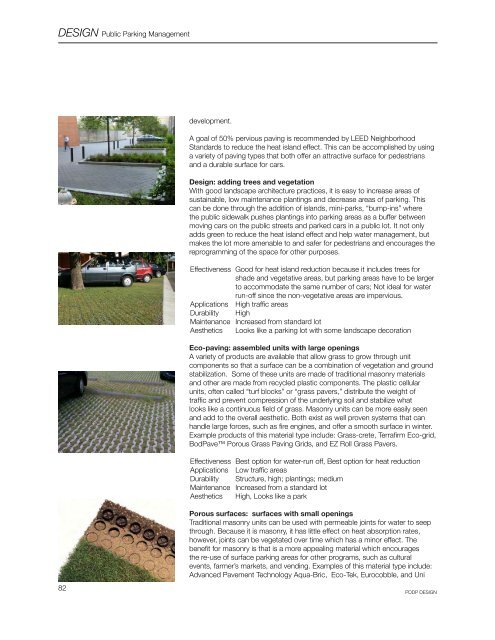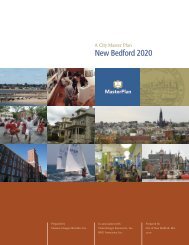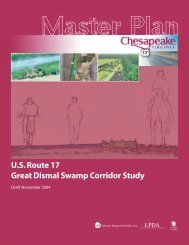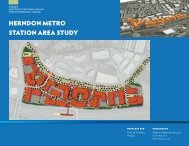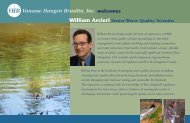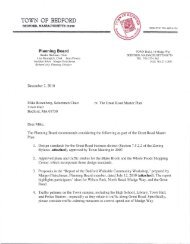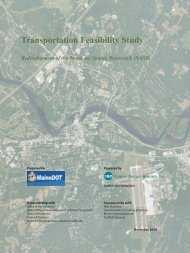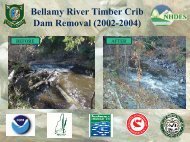PAWTUCKET DOWNTOWN DESIGN PLAN FINAL ... - VHB.com
PAWTUCKET DOWNTOWN DESIGN PLAN FINAL ... - VHB.com
PAWTUCKET DOWNTOWN DESIGN PLAN FINAL ... - VHB.com
You also want an ePaper? Increase the reach of your titles
YUMPU automatically turns print PDFs into web optimized ePapers that Google loves.
<strong>DESIGN</strong> Public Parking Management<br />
development.<br />
A goal of 50% pervious paving is re<strong>com</strong>mended by LEED Neighborhood<br />
Standards to reduce the heat island effect. This can be ac<strong>com</strong>plished by using<br />
a variety of paving types that both offer an attractive surface for pedestrians<br />
and a durable surface for cars.<br />
Design: adding trees and vegetation<br />
With good landscape architecture practices, it is easy to increase areas of<br />
sustainable, low maintenance plantings and decrease areas of parking. This<br />
can be done through the addition of islands, mini-parks, “bump-ins” where<br />
the public sidewalk pushes plantings into parking areas as a buffer between<br />
moving cars on the public streets and parked cars in a public lot. It not only<br />
adds green to reduce the heat island effect and help water management, but<br />
makes the lot more amenable to and safer for pedestrians and encourages the<br />
reprogramming of the space for other purposes.<br />
Effectiveness Good for heat island reduction because it includes trees for<br />
shade and vegetative areas, but parking areas have to be larger<br />
to ac<strong>com</strong>modate the same number of cars; Not ideal for water<br />
run-off since the non-vegetative areas are impervious.<br />
Applications High traffic areas<br />
Durability High<br />
Maintenance Increased from standard lot<br />
Aesthetics Looks like a parking lot with some landscape decoration<br />
Eco-paving: assembled units with large openings<br />
A variety of products are available that allow grass to grow through unit<br />
<strong>com</strong>ponents so that a surface can be a <strong>com</strong>bination of vegetation and ground<br />
stabilization. Some of these units are made of traditional masonry materials<br />
and other are made from recycled plastic <strong>com</strong>ponents. The plastic cellular<br />
units, often called “turf blocks” or “grass pavers,” distribute the weight of<br />
traffic and prevent <strong>com</strong>pression of the underlying soil and stabilize what<br />
looks like a continuous field of grass. Masonry units can be more easily seen<br />
and add to the overall aesthetic. Both exist as well proven systems that can<br />
handle large forces, such as fire engines, and offer a smooth surface in winter.<br />
Example products of this material type include: Grass-crete, Terrafirm Eco-grid,<br />
BodPave Porous Grass Paving Grids, and EZ Roll Grass Pavers.<br />
Effectiveness Best option for water-run off, Best option for heat reduction<br />
Applications Low traffic areas<br />
Durability Structure, high; plantings; medium<br />
Maintenance Increased from a standard lot<br />
Aesthetics High, Looks like a park<br />
82<br />
Porous surfaces: surfaces with small openings<br />
Traditional masonry units can be used with permeable joints for water to seep<br />
through. Because it is masonry, it has little effect on heat absorption rates,<br />
however, joints can be vegetated over time which has a minor effect. The<br />
benefit for masonry is that is a more appealing material which encourages<br />
the re-use of surface parking areas for other programs, such as cultural<br />
events, farmer’s markets, and vending. Examples of this material type include:<br />
Advanced Pavement Technology Aqua-Bric, Eco-Tek, Eurocobble, and Uni<br />
PDDP <strong>DESIGN</strong>


